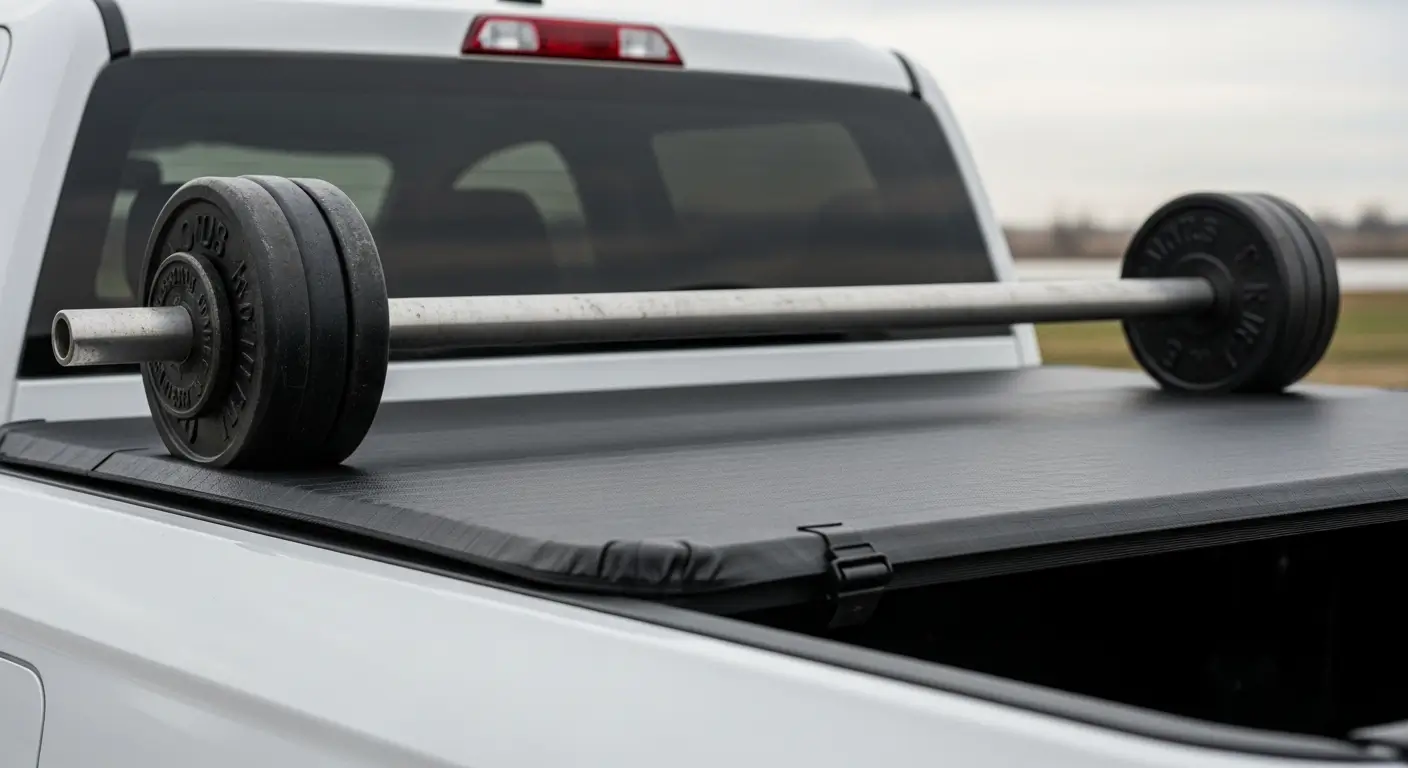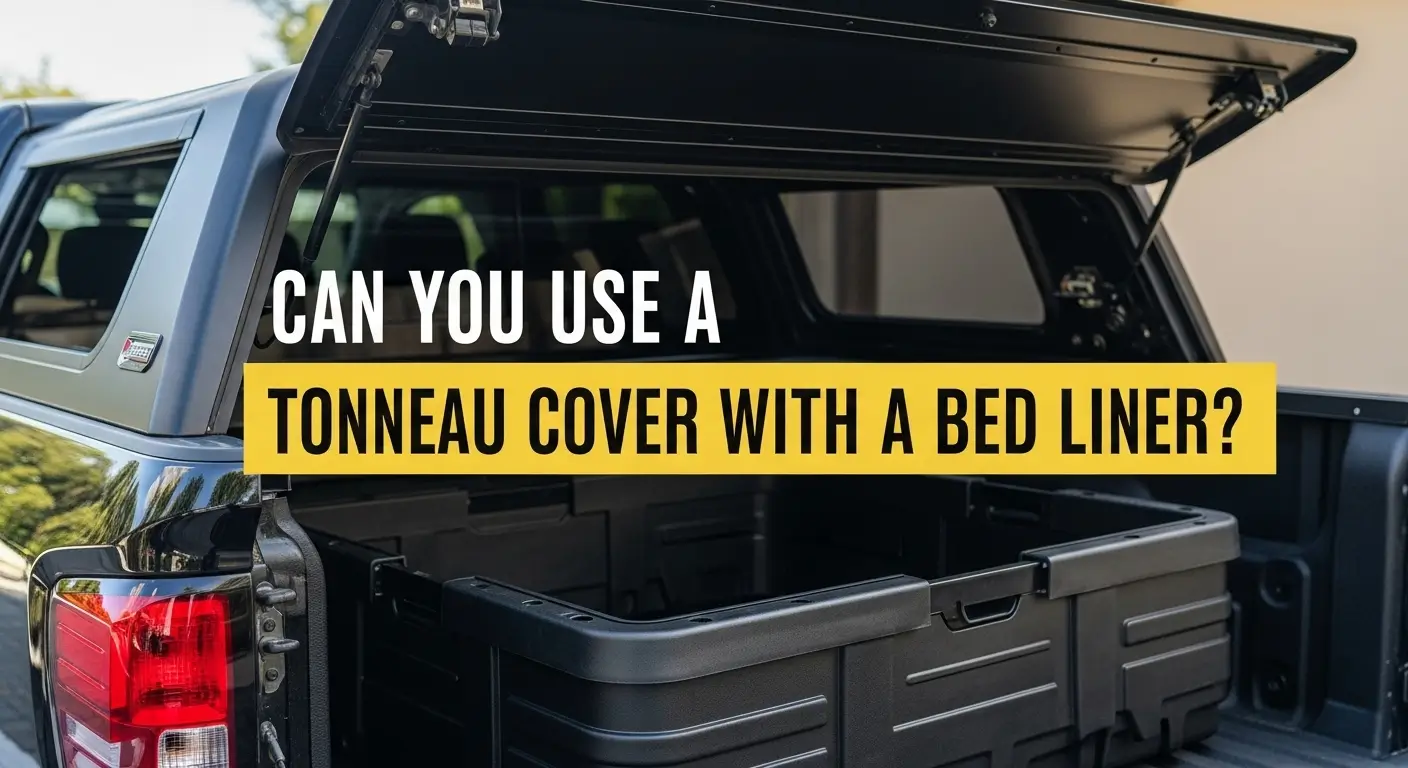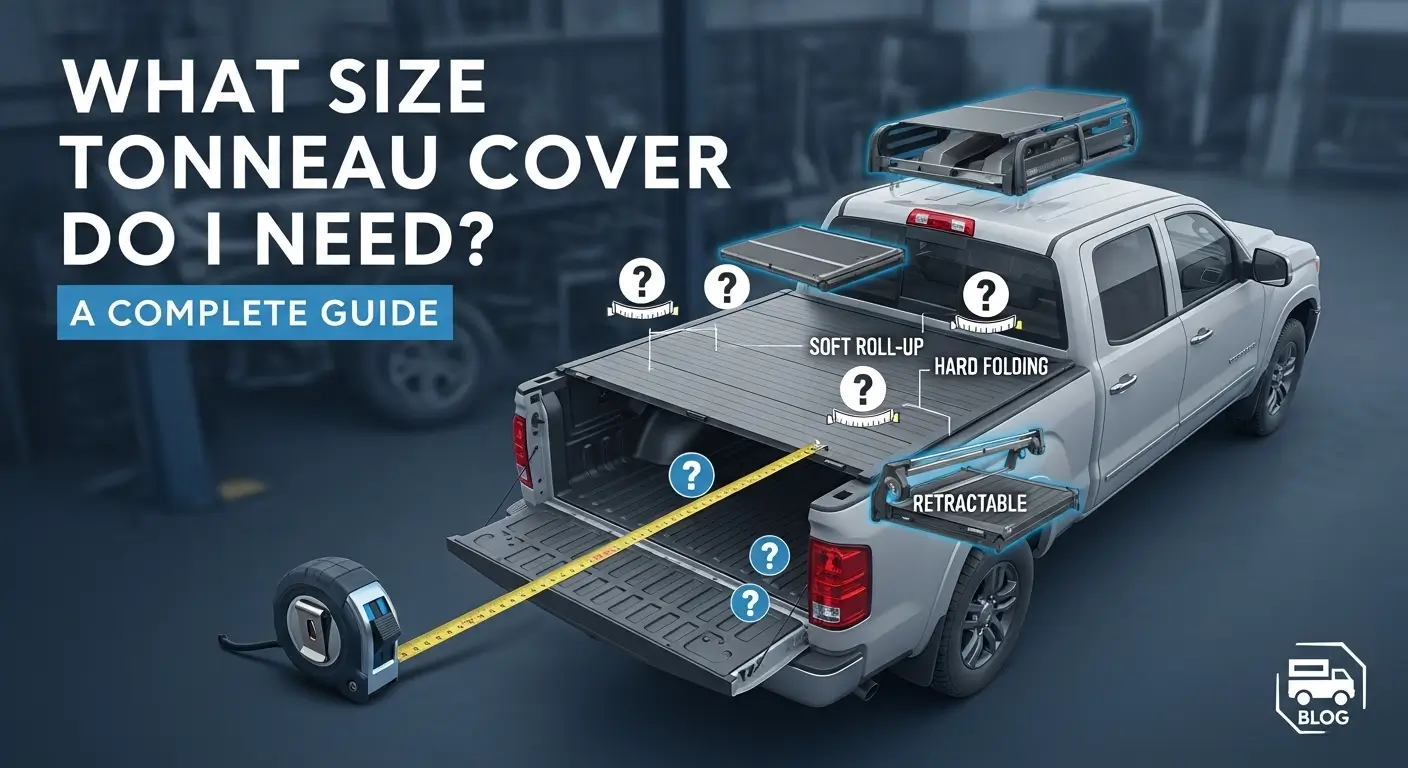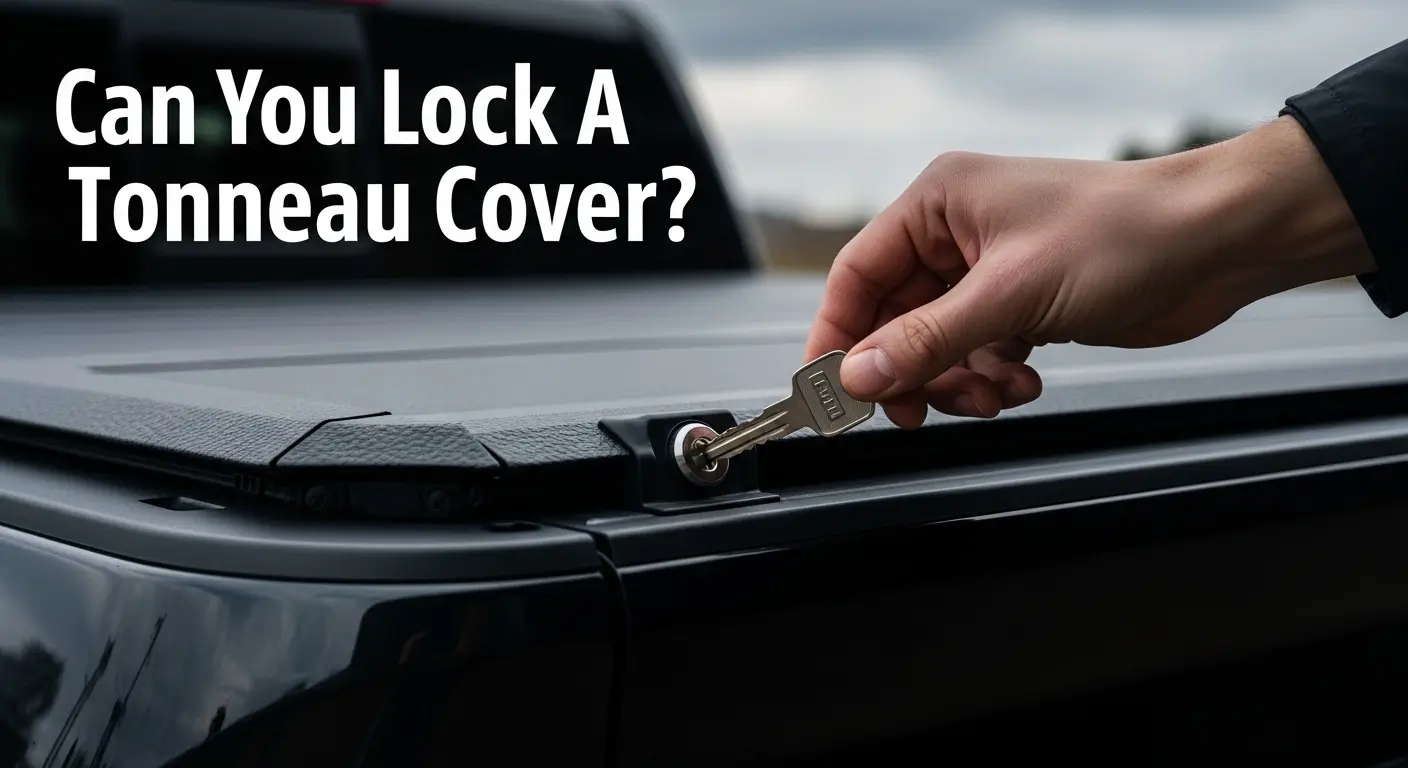Tonneau covers come in many styles – from soft roll-up vinyls to solid aluminum panels – and their strength varies just as much. Knowing a cover’s weight capacity is vital if you plan to haul gear, stack cargo or brave heavy snow on your truck bed.
Soft canvas or vinyl covers are lightweight and protect cargo from weather, but they can only hold a few dozen pounds (barely enough for leaves or a light cooler).
Hard covers made of aluminum, composite or ABS panels are far stronger – many are rated for several hundred pounds of evenly distributed load.
In fact, the toughest covers (like Renegade and DiamondBack models) advertise capacities in the thousands of pounds.
This article breaks down tonneau cover types and materials, compares their load limits, and offers practical tips for safely using your cover as a load-bearing surface.
Also check- Truck bed cover impact on fuel economy
Table of Contents
Bulleted Takeaways
- Soft vs. Hard: Soft covers (vinyl/canvas) – very low capacity (~20-30 lbs). Hard covers (aluminum/composite panels) – high capacity (~300-600 lbs).
- Distribute Weight: Always place heavy items across the entire cover. Avoid loading one corner or edge heavily.
- Snow Loads: Be mindful of heavy wet snow. Clear thick accumulations to avoid exceeding static load.
- Manufacturer Limits: Cover ratings typically assume even, static load. Real driving forces are higher; keep on-road loads below static limits.
- Specialty Options: Ultra-heavy-duty covers exist (1600-2000 lbs) if you need maximum hauling capability.
- Maintenance: Keep clamps tight, seals intact, and hinge pins greased. A well-maintained cover meets its capacity longer.
Tonneau Cover Types and Typical Load Limits
Different tonneau cover designs have very different strength. Below is an overview of the major types and their approximate weight capacities:
Table: Tonneau Cover Styles & Weight Capacity
| Cover Style | Material/Design | Typical Capacity | Examples / Notes |
|---|---|---|---|
| Soft Roll-Up | Vinyl/Canvas over bows | ~15-30 lbs | Access™, Truxedo TruXport™ (soft vinyl covers) |
| Soft Tri-Fold | Vinyl/Canvas on aluminum frame | ~20-30 lbs | Tyger Auto™ T3 Soft Tri-Fold |
| Hard Roll-Up | Interlocking aluminum slats | ~200-400 lbs | BAK Revolver™ X4s, TruXedo® Sentry (400 lbs) |
| Hard Folding (Tri-Fold) | Aluminum or FRP panels | ~300-600 lbs | BAKFlip® F1/MX4 (~400 lbs), Extang SolidFold (600 lbs) |
| One-Piece Hard Cover | ABS/fiberglass single lid | ~400-600 lbs | UnderCover® SE (~500 lbs) |
| Ultra-Heavy-Duty Hard Cover | Reinforced aluminum panels | 1000-2000+ lbs | Renegade™ (2000 lbs), DiamondBack® HD (1600 lbs) |
Note: Capacities refer to static, evenly distributed loads (e.g. cargo or snow spread across the cover). Concentrated loads (standing in one spot) should be much less (often only 50-100 lbs per point).

Soft Roll-Up & Tri-Fold Covers (Vinyl/Canvas)
These budget-friendly covers use a vinyl or fabric top stretched over aluminum bows or frames.
Load Capacity: Only 15-50 lbs at most. Exceeding ~20-30 lbs can strain the material. These covers sag under heavy weight and are meant for weather protection, not hauling. Use Case: Light-duty (snow, leaves, or small cargo).
Hard Folding Covers (Aluminum/Composite Panels)
Multi-panel covers (usually tri-fold) made of aluminum or composite panels (like fiberglass-reinforced polymer).
Load Capacity: Roughly 300-600 lbs when weight is evenly spread. For example, BAKFlip and Extang Solid Fold series list about 400-600 lbs capacity under static loads.
These covers use strong frames and hinges to bear weight. Use Case: Regular-duty hauling (skis, lumber, toolboxes on the closed cover).
Hard Roll-Up (Retractable) Covers
Aluminum or polycarbonate slats under a vinyl skin that roll into a canister.
Load Capacity: Typically 200-400 lbs evenly distributed. Brands like BAK Revolver and TruXedo Sentry often rate around 400 lbs.
The interlocking slats give strength, but retractable mechanisms can limit heavy loading. Use Case: Moderate hauling (canoes, bicycles when evenly supported), with easy bed access.
One-Piece Hard Covers (Fiberglass/ABS)
A single rigid lid that flips open hinged at cab.
Load Capacity: Approximately 400-600+ lbs. For instance, UnderCover one-piece covers boast ~500 lbs capacity.
These covers lack hinges in the middle, so they can support large static loads. Use Case: Heavy hauling on cover (camping gear, cargo baskets).
Ultra-Heavy-Duty Covers
Specialty covers built for extreme loads.
Load Capacity: Over 1000 lbs. Examples include the Renegade hard fold (rated up to 2000 lbs) and DiamondBack HD (rated 1600 lbs).
These use reinforced aluminum and framing. Use Case: Very heavy loads or rooftop tents. (These are premium, high-cost options.)
Popular Covers and Their Weight Capacities
For a sense of scale, here are some examples of well-known covers and their advertised load limits (static, evenly distributed):
1. Renegade Hard Folding Cover: Load capacity ~2000 lbs. Engineered with military-grade aluminum and heavy frames; stands at the extreme end of the market.
2.DiamondBack HD (Heavy Duty): Load capacity ~1600 lbs. Patented StrongHauL design with extra support rails.
3. Extang Solid Fold 2.0: Load capacity 600 lbs. Upgraded FRP panels with reinforced hinges.
3. UnderCover Elite (One-Piece ABS): Load capacity ~500 lbs. Lightweight ABS panels with internal ribbing.
4. BAKFlip F1/MX4: Load capacity ~400 lbs. FRP/aluminum composite panels. (The original BAKFlip G2 was ~400 lbs; the new MX4 offers similar strength).
5. BAK Revolver X4s (Hard Roll-Up): Load capacity 400 lbs. Aluminum slats under vinyl top.
6. TruXedo Sentry (Hard Roll-Up): Load capacity 400 lbs. (Q&A from etrailer confirms 400 lbs if evenly distributed.
7. Gator SRX or G2: Load capacity ~400 lbs. Sturdy tri-fold cover with aluminum panels.
8. RetraxPRO MX (Retractable): Load capacity ~300-400 lbs. Many retractables are around this range.
9. Tyger T3 Soft Tri-Fold: Load capacity 20-30 lbs. (As a soft cover, it sags under heavier loads.)
10 .ACCESS Original (Soft Roll-Up): Load capacity ~50 lbs. Vinyl roll-up covers are weak weight-wise.
These examples illustrate the gap: soft covers (~30 lbs) vs hard covers (~400+ lbs) vs specialty covers (1000+ lbs). Always check the specific cover’s product info. If you don’t see a weight rating listed, assume it’s on the low end (especially for soft or soft-top covers).
How Cover Material Affects Strength
The materials used make a huge difference in load-bearing capability:
Vinyl/Canvas (Soft Covers): Flexible and weatherproof, but very low strength. Vinyl covers will droop under even 30-50 lbs, and heavy objects will tear them. Typical support: 15-50 lbs (mostly for snow or linens).
Aluminum Frames: Many hard covers use aluminum frames or panels. Aluminum is lightweight yet strong. Solid aluminum panels (like in hard tri-folds) easily support 300-500 lbs. Even thin aluminum slats in roll-up covers can handle 200-400 lbs when interlocked.
Fiberglass-Reinforced Polymer (FRP): A composite (plastic + fiberglass) that’s lighter than pure fiberglass but very strong. FRP panels (used in covers like Extang or BAKFlip) typically support 400-600 lbs evenly. FRP resists dents and temperature extremes.
ABS Composite: A tough plastic (often reinforced) used in premium one-piece covers (e.g. UnderCover). ABS panels are lightweight but rigid, and can carry up to ~500 lbs. Some ABS covers feature built-in ribbing (like the UnderCover X-Effect) for strength.
Fiberglass: Solid fiberglass lids are heavy and strong, often on par with aluminum panels. They typically handle 400-500 lbs. The structural “honeycomb” or ribbing inside a fiberglass lid spreads the load.
Reinforced/Coated Aluminum (Ultra Duty): Covers like DiamondBack HD spray-coat diamond-plate aluminum. These engineered panels with internal supports can carry over 1000 lbs. Specialized covers incorporate cross-bows and cleats to distribute extremely heavy weight.
In summary, flexible soft materials = low capacity (tens of lbs), while rigid metal/plastic panels = high capacity (hundreds of lbs or more).
Many covers use mixed materials: for instance, a “hard roll-up” has a vinyl top but uses aluminum slats internally, giving moderate strength.
When evaluating a cover, check the materials: soft tops (vinyl/canvas) should not be trusted for heavy loads, whereas covers touting aluminum or composite panels are built for load-bearing.
Comparing Covers: Which Is Right for You?
Light Cargo / Budget: If you’re mainly covering gear (tools, tarps) and never hauling atop the cover, a soft or basic hard cover is fine.
Price is lower ($200-$500), and you get weather protection. Expect 15-50 lbs capacity.
Moderate Hauling: If you sometimes need to carry bikes, lumber, snowboards on the cover, go with a hard folding or hard roll-up cover.
Most from well-known brands cost $500-$1500 and hold 300-500 lbs. They also lock for security.
Heavy-Duty Use: If you truly need a working platform (e.g. mount a rooftop tent or haul ATV ramps, building materials), invest in a heavy-duty cover (DiamondBack HD, Renegade, etc.).
These are $2000+ but designed for 1000+ lbs. They often include anchor cleats and reinforced frames.
Bed Access vs. Strength: One-piece covers (hardshells) often have the highest ratings, but they give up ⅔ bed access unless fully removed.
Tri-folds give ⅔ or full access and still handle hundreds of lbs. Retractable covers provide 100% access when rolled, but check their rating (some retractables are only ~300 lbs). Choose based on how often you fold/open the cover.
Weight Distribution Considerations: For peak strength, some covers (like Extang) allow supporting up to 600-800 lbs, but pay attention to how they define “evenly distributed.”
Often it means spread across multiple panels or the whole cover. If most of your load will sit on one panel or near the tailgate, check that a given cover can handle that in one spot (many cannot).
Conclusion
In summary, a tonneau cover’s weight limit depends on its style and build. Soft vinyl tops hold only a few dozen pounds, whereas hard aluminum/composite covers handle several hundred pounds – and purpose-built heavy-duty covers exceed a thousand.
Always check the cover’s specs and use it within those limits: evenly distribute loads, secure cargo, and remove heavy snow promptly.
With the right cover matched to your hauling needs, you can keep cargo secure and make the most of your truck bed, even using the cover as an extra load platform.
Whether you’re planning to carry lumber for a project or just need to clear off snowy loads, this guide should help you pick a cover that works for you.
Now that you know what to look for, choose a cover with the strength to support your gear – and drive with confidence knowing your tonneau cover can truly do more than just shield your cargo.






